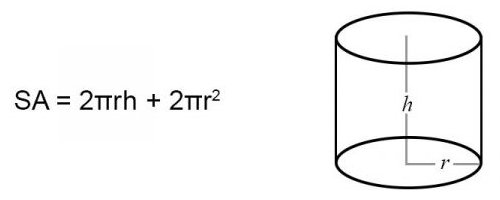Surface Area of a Cylinder Lesson
Cylinder Surface Area Formula
The formula for surface area of a cylinder is given as:
SA = 2πrh + 2πr2
Where SA is the surface area, r is the radius of the base circle, and h is the height of the cylinder.

INTRODUCING

Surface Area of a Cylinder Example Problems
Let's go through a couple of example problems together to practice finding the surface area of a cylinder.
Example Problem 1
What is the surface area of a cylinder with a diameter of 20 and a height of 20?
Solution:
- Let's convert diameter to radius. D = 2r, 20 = 2r, so r = 10.
- Now let's plug the radius and height into the surface area formula.
- SA = 2πrh + 2πr2
- SA = 2π(10)(20) + 2π(102) = 2π(200) + 2π(100)
- SA = 1,884.956
- The surface area is 1,884.956.
Example Problem 2
A cylinder is measured to have a surface area of 24 square meters. It's height and radius are equal. What is the height of the cylinder?
Solution:
- Let's set up relations between height and radius that we can substitute into the formula.
- h = r
- rh = h2
- r2 = h2
- Now let's plug what we know into the surface area formula and solve for h.
- SA = 2πrh + 2πr2
- 24 = 2πh2 + 2πh2
- 24 = 4πh2
- 1.910 = h2
- h = 1.382
- The height of the cylinder is 1.382 meters.

